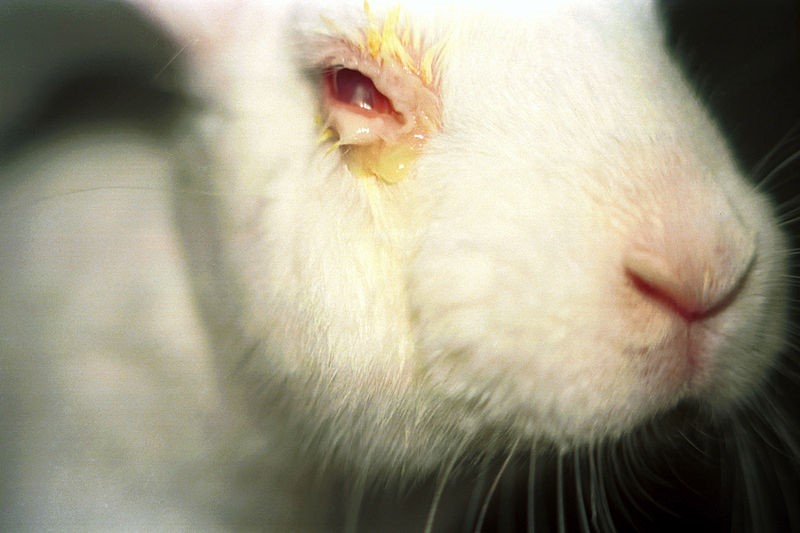However, since previous tissue models do not allow the differentiation between irreversible and reversible damage, the Draize test could only be reduced and not replaced, a recent press release on the subject stated.
No replacement despite numerous developments
Some in vitro eye irritation tests have already been developed earlier. In September 2009, the OECD approved an in vitro test with isolated bovine corneas (BCOP test) (Test Guideline 437), which can be used as a replacement for this Draize test.
The short-term toxicology laboratory of the chemical giant BASF had developed and certified a device, called the opacitometer, to measure the effects of substances on this eye tissue. However, the BCOP test was developed for the detection of substances that are highly irritating to the eyes. Besides, several cornea models made from human cells have also been developed in recent years.

Still waiting for the privilege of look with intact eyes: rabbits in Draize test
Photo: People for the Ethical Treatment of Animals (PETA)
However, there is currently no approved test that can differentiate between slightly irritating and non-irritating effects. Therefore, a tiered testing strategy consisting of two combined methods, the BCOP test, and a reconstructed human tissue cornea model, has been proposed by the BASF laboratory to the OECD to eventually completely replace the Draize test. With this new model, highly irritant substances (GHS category 1), moderate or slightly irritant substances (GHS category 2), and non-irritant substances could be routinely tested and correctly classified.
In addition to BCOP, there is another test that can also be used as an alternative to the use of rabbits since 2018: the Isolated Chicken Eye Test (OECD Test Guideline 438) with eyes of slaughtered chickens. It enables the detection of severely harmful substances for which a classification according to the GHS system (Globally Harmonized System) is not necessary. There is also a test procedure with reconstituted human Cornea-like surface tissue (RhCE) according to Test Guideline 492. and the Vitrigel-Eye Irritancy Test Method (Test Guideline 494).
Four years ago a working group was even established at the UN. Here, the Joint Research Center, together with the European Chemicals Agency (ECHA) and the Directorates Environment, Internal Market, Industry, Entrepreneurship and SMEs of the European Commission is an active member. The working group is currently developing criteria for the assessment of severe eye damage and irritation to achieve international agreement on the introduction of animal-free methods for the classification of ocular effects.
However, the OECD pointed out that no single eye irritation test is capable of replacing the in vivo rabbit test for the assessment of the full spectrum of irritation and a wide range of chemicals. However, this could be achieved by combining animal-free methods in a tiered or integrated testing strategy (1). For this reason, Guidance Document No. 263 on an Integrated Approach (IATA) to the Assessment of Severe Eye Damage and Irritation has been in existence since 2017 (2).
This shows that more could perhaps have been achieved with a focused exit strategy and goal-oriented pursuit and development of still missing aspects of a test strategy.
Scientists from Aachen had already developed the EVEIT test in 2014, which can be used to test chemical, pharmacological, and cosmetic substances and products. While the BCOP test can only be used to test chemicals for their acute effects, the EVEIT system can also be used to observe healing or non-healing within a defined time (3). According to this, a test for reversibility has been in existence for years - but in the rabbit eye of slaughter animals (4).
The new project in Würzburg is financed by the German Federal Ministry of Education and Research within the framework of the funding program "Alternatives to animal experiments".
Source:
https://www.regenerative-therapien.fraunhofer.de/de/aktuelle-projekte-und-news/projektstart-ImAi-weltweiten-standard-tierversuch-ersetzen.html
Additional:
(1) https://www.oecd-ilibrary.org/
(2) https://www.oecd.org/
(3) https://www.invitrojobs.com/index.php/en/research-and-methods/working-group-a-portrait/item/1072-working-group-a-portrait-acto-e-v
(4) https://www.acto.de/eveit.html




 Dr. rer. nat.
Dr. rer. nat. Menschen für Tierrechte - Tierversuchsgegner Rheinland-Pfalz e.V.
Menschen für Tierrechte - Tierversuchsgegner Rheinland-Pfalz e.V.